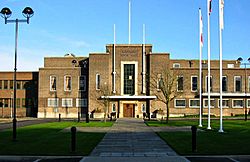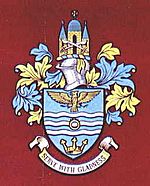Municipal Borough of Romford facts for kids
| Romford | |
| Motto: Serve with gladness | |
 Romford Town Hall |
|
 Romford within Essex in 1961 |
|
| Geography | |
| Status | Local board district (1851–1894) Urban district (1894–1937) Municipal borough (1937–1965) |
| 1911 area | 5,630 acres (22.8 km2) |
| 1931 area | 5,627 acres (22.8 km2) |
| 1961 area | 9,342 acres (37.8 km2) |
| HQ | Romford |
| History | |
| Created | 1894 |
| Abolished | 1965 |
| Succeeded by | London Borough of Havering |
Quick facts for kids Demography |
|
|---|---|
| 1911 population - 1911 density |
16,970 3/acre |
| 1931 population - 1931 density |
35,918 6/acre |
| 1961 population - 1961 density |
114,584 12/acre |
| Politics | |
| Governance | Romford Board of Health (1851–1894) Romford Urban District Council (1894–1937) Romford Borough Council (1937–1965) |
 Coat of arms of the borough council |
|
| Subdivisions | |
| Type | Civil parishes |
| Units | Romford (1851–1894) Romford Urban (1894–1900) Romford (1900–1965) Noak Hill (1934–1965) Havering-atte-Bower (1934–1965) |
Romford was a special area in southwest Essex, England. It had its own local government from 1851 to 1965. Over time, Romford grew a lot. Its population became much larger, and it gained important status as a municipal borough in 1937. Today, the area that was once Romford is part of the northern London Borough of Havering in Greater London.
Contents
How Romford's Government Started
Romford began as a small part of the historic Liberty of Havering. In 1849, it became its own civil parish. A civil parish is a local area with its own council.
Setting Up Local Control
In 1851, a group called the local board of health was created for Romford. This board helped manage local services like health and sanitation. At first, it covered the whole parish. But in 1855, its area was made smaller to only include the town part of Romford.
The local board met in different places. From 1851 to 1853, they met at St Edward's Hall. Then, they used the old liberty court house until 1869. After that, they moved to offices in the marketplace. Finally, in 1892, they bought the old court house.
Becoming an Urban District
In 1894, the area managed by the local board became the Romford Urban District. This change happened because of a law called the Local Government Act 1894. This also split the Romford parish into two parts: Romford Urban (the town) and Romford Rural (the countryside). The rural part became part of the Romford Rural District.
Romford's Growth and New Status
From 1894 to 1900, the urban district was just the civil parish of Romford Urban. In 1900, the two Romford parishes joined back together. This made the urban district bigger, covering the whole Romford parish until 1934.
Expanding the District
The Romford Urban District was surrounded by the Romford Rural District. But in 1934, the rural district was ended. Romford Urban District then grew even more. It took in the parishes of Noak Hill and Havering-atte-Bower.
The urban district council used to meet at the old court house. But this building was taken down in 1933.
Becoming a Borough
In 1937, the Romford Urban District became a municipal borough. This was a more important type of local government. The council then moved to a brand new town hall on Main Road.
Community Improvements
The local board bought Romford Market in 1892. This meant they could manage the market for the community. Public swimming baths were also built in Mawney Road in 1900. These baths gave people a place to swim and relax.
The End of Romford's Local Government
A special group called the Royal Commission on Local Government in Greater London looked at Romford. They decided it should become part of Greater London. So, in 1965, the municipal borough of Romford was officially ended. This happened because of the London Government Act 1963.
Romford's area was then moved from Essex to Greater London. It joined with the area of Hornchurch Urban District. Together, they formed the new London Borough of Havering that we know today.
Population Changes Over Time
This table shows how Romford's population grew over the years.
| Year | 1901 | 1911 | 1921 | 1931 | 1941 | 1951 | 1961 |
|---|---|---|---|---|---|---|---|
| Population | 13,656 | 16,970 | 19,442 | 35,918 | 88,002 | 114,584 |
Images for kids
See also
- John Basil Poel




